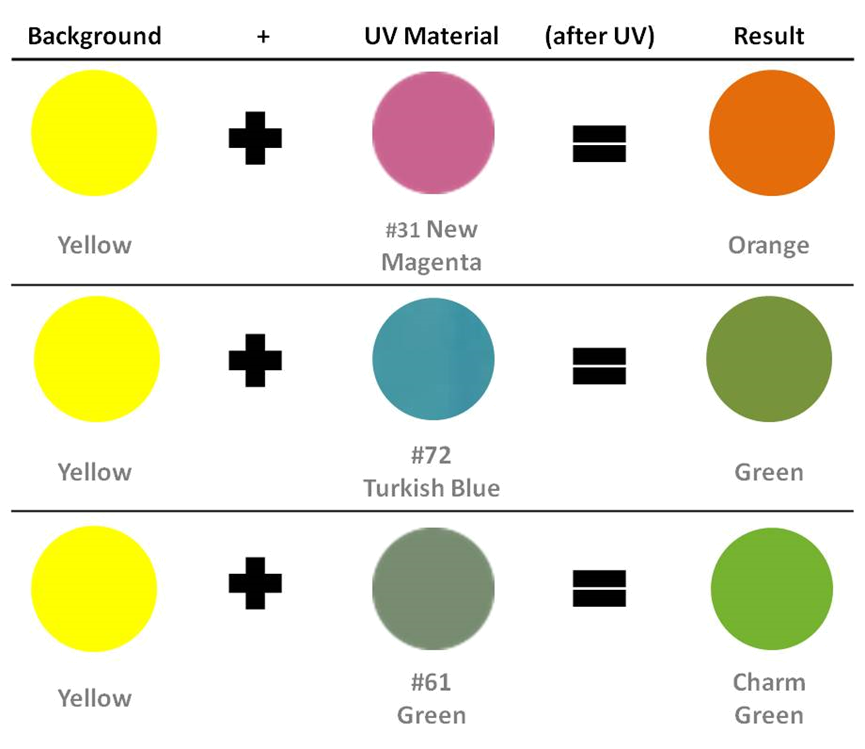A. Introduction
Photochromic materials absorb the energy of sunlight/UV rays to produce changes in their molecular structure. The change in the absorption wavelength causes color changes. As the energy of sunlight/UV rays is lost, the original molecular structure is restored and return to the original color. This is a reversible color change.
B. Discoloration Principle
|
Without UV rays: Colorless |
Under UV rays: Colored |
|
|
|
C. Product Type and Applicable Table
1. OP Dye: Suitable for solvent-based systems and plastic processing.
2. Slurry: Suitable for water-based systems.
3. MC powder: Suitable for solvent-based systems and plastic processing.
4. Master batch: Suitable for plastic processing.

D. Product introduction and instructions
1. OP Dye
1.1 Colors (For reference only)
 |
 |
 |
 |
|
#12 Purple
|
#13 Sky Blue
|
#14 Blue
|
#16 Yellow
|
 |
 |
 |
 |
|
#17 Peach Orange
|
#18 Orange
|
#19 Magenta
|
#22 Grey
|
 |
 |
 |
 |
|
#33 Grenadine
|
#34 Carmine
|
#62 Dark Jungle Green
|
#84 Amethyst
|
1.2 Description
![]() OP dye itself does not change color when irradiated and needs to be dissolved in a medium such as solvents, resins, and plastics, to be sensitive to UV rays to change in color. It shows different color edge in different polarities.
OP dye itself does not change color when irradiated and needs to be dissolved in a medium such as solvents, resins, and plastics, to be sensitive to UV rays to change in color. It shows different color edge in different polarities.
1.3 Properties
![]() OP dyes are organic dyes, which can achieve complete light transmission. It can be used in plastic processing, solvent-based inks and coatings. Different colors of OP dyes have different degrees of color development and decolorization speed.
OP dyes are organic dyes, which can achieve complete light transmission. It can be used in plastic processing, solvent-based inks and coatings. Different colors of OP dyes have different degrees of color development and decolorization speed.
1.4 Usage (e.g. 20μm film formation, 0.2cm plastic molding)
![]() For solvent based ink/paint 0.02%-0.3% w/w (0.5%)
For solvent based ink/paint 0.02%-0.3% w/w (0.5%)
![]() For plastic injection/extrusion 0.01%-0.3% w/w (0.01%)
For plastic injection/extrusion 0.01%-0.3% w/w (0.01%)
1.5 Precautions
![]() Processing temperature: When applied to plastic injection and extrusion, processing temperature should be lower than 200℃. Heat stabilizer can be added.
Processing temperature: When applied to plastic injection and extrusion, processing temperature should be lower than 200℃. Heat stabilizer can be added.
![]() Light fatigue: UV light overexposure, acid, free radicals and humidity will cause the light fatigue of the photochromic material. It is recommended to add UV absorbers and antioxidants to increase light fastness, but too much UV absorber may block the absorption of UV rays, resulting in poor discoloration effect, or even failure to discolor.
Light fatigue: UV light overexposure, acid, free radicals and humidity will cause the light fatigue of the photochromic material. It is recommended to add UV absorbers and antioxidants to increase light fastness, but too much UV absorber may block the absorption of UV rays, resulting in poor discoloration effect, or even failure to discolor.
![]() Solubility: Different colors of OP dyes have different solubility in formulations. Our standard formulations can be used for inks and coatings. For the solubility of OP dyes in different solvents, please contact us.
Solubility: Different colors of OP dyes have different solubility in formulations. Our standard formulations can be used for inks and coatings. For the solubility of OP dyes in different solvents, please contact us.
2. Photochromic Slurry
2.1 Colors (For reference only)
 |
 |
 |
 |
|
#31 New Magenta
|
#32 Red
|
#33 Grenadine
|
#34 Carmine
|
 |
 |
 |
 |
|
#41 New Orange
|
#51 New Yellow
|
#61 Green
|
#62 Dark Jungle Green
|
 |
 |
|
 |
|
#71 New Blue
|
#72 Turkish
|
#73 Canal Blue
|
#81 New Purple
|
 |
 |
 |
|
|
#82 Deep Purple Blue
|
#83 Vivid Reddish Purple
|
#84 Amethyst
|
#91 Dark Charcoal Grey
|
2.2 Description
![]() Photochromic slurry is a microencapsulated aqueous dispersion with good dispersal in water, suitable for water based paint.
Photochromic slurry is a microencapsulated aqueous dispersion with good dispersal in water, suitable for water based paint.
![]() Particle size: less than 5μm
Particle size: less than 5μm
![]() Solid content: 40±5%, different content for different colors.
Solid content: 40±5%, different content for different colors.
2.3 Properties
![]() Protected by microcapsules, photochromic slurry can change color steadily. The water emulsion is a pigment type. Different models will produce varying degrees of masking effects.
Protected by microcapsules, photochromic slurry can change color steadily. The water emulsion is a pigment type. Different models will produce varying degrees of masking effects.
2.4 Usage(e.g. 20μm film formation)
![]() For aqueous based ink/paint 5%-60% w/w (25%)
For aqueous based ink/paint 5%-60% w/w (25%)
2.5 Precautions
![]() Slurry may gather together during storage. Heat the slurry to 45℃ in a double boiler to disperse.
Slurry may gather together during storage. Heat the slurry to 45℃ in a double boiler to disperse.
![]() Avoid any high polarity solvents since the microcapsules may be permeated and the contents may be affected.
Avoid any high polarity solvents since the microcapsules may be permeated and the contents may be affected.
3. Photochromic Microcapsulated Powder
3.1 Colors (For reference only)
 |
 |
 |
 |
|
#31 New Magenta
|
#32 Red
|
#33 Grenadine
|
#34 Carmine
|
 |
 |
 |
 |
|
#41 New Orange
|
#42 Melon Orange
|
#51 New Yellow
|
#61 Green
|
 |
 |
 |
|
|
#62 Dark Jungle Green
|
#71 New Blue
|
#72 Turkish Blue
|
#73 Canal Blue
|
 |
 |
 |
 |
|
#81 New Purple
|
#82 Deep Purple Blue
|
#83 Vivid Reddish Purple
|
#84 Amethyst
|
|
|
|||
|
#91 Dark Charcoal Grey
|
3.2 Description
![]() Photochromic microencapsulated powder contains 2-5 % photochromic dye. Suitable for solvent and aqueous based ink/paint and plastic injection and extrusion.
Photochromic microencapsulated powder contains 2-5 % photochromic dye. Suitable for solvent and aqueous based ink/paint and plastic injection and extrusion.
![]() Particle size: less than 10μm
Particle size: less than 10μm
![]() Moisture content: less than 3%
Moisture content: less than 3%
3.3 Properties
![]() Photochromic microencapsulated powder is a pigment with bright color, high temperature resistance and solvent resistance. It can be used in plastic processing, oil-based inks and coatings.
Photochromic microencapsulated powder is a pigment with bright color, high temperature resistance and solvent resistance. It can be used in plastic processing, oil-based inks and coatings.
3.4 Usage(e.g. 20μm film formation, 0.2cm plastic molding)
![]() For solvent/aqueous based ink/paint 3%-30% w/w (25%)
For solvent/aqueous based ink/paint 3%-30% w/w (25%)
![]() For plastic injection/extrusion 0.2%-1% w/w (0.05%)
For plastic injection/extrusion 0.2%-1% w/w (0.05%)
3.5 Precautions
![]() Processing temperature: When applied to plastic injection and extrusion, processing temperature should be lower than 200℃. Heat stabilizer can be added.
Processing temperature: When applied to plastic injection and extrusion, processing temperature should be lower than 200℃. Heat stabilizer can be added.
4. Photochromic Masterbatch
4.1 Description
![]() Our standard photosensitive masterbatch is made by mixing 1% photochromic dye and 99% plastic material, UV stabilizer and antioxidant.
Our standard photosensitive masterbatch is made by mixing 1% photochromic dye and 99% plastic material, UV stabilizer and antioxidant.
4.2 Properties
![]() Dispersed and used easily, can be directly applied to plastic injection/extrusion.
Dispersed and used easily, can be directly applied to plastic injection/extrusion.
4.3 Usage(e.g. 0.2cm plastic molding)
![]() For plastic injection/extrusion 1%-5% w/w(1%)
For plastic injection/extrusion 1%-5% w/w(1%)
4.4 Precautions
![]() Standard material: PE.
Standard material: PE.
![]() Other available material: PP. TPU. TPR. EVA.
Other available material: PP. TPU. TPR. EVA.
![]() Photochromic masterbatch is made with special formulations. Its color changing effect is different from the effects of photochromic powder and dye
Photochromic masterbatch is made with special formulations. Its color changing effect is different from the effects of photochromic powder and dye
E. Miscellaneous
1. Colored to colored (For reference only)



